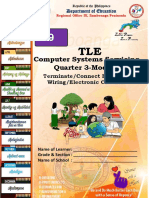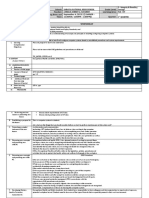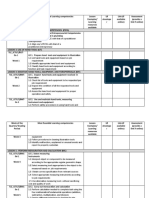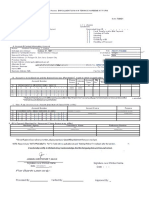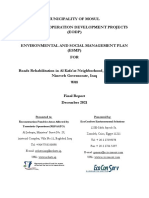Grade 10 TLE
Grade 10 TLE
Uploaded by
Jhobhel Christopher GalivoCopyright:
Available Formats
Grade 10 TLE
Grade 10 TLE
Uploaded by
Jhobhel Christopher GalivoOriginal Description:
Copyright
Available Formats
Share this document
Did you find this document useful?
Is this content inappropriate?
Copyright:
Available Formats
Grade 10 TLE
Grade 10 TLE
Uploaded by
Jhobhel Christopher GalivoCopyright:
Available Formats
Grade 10 TLE-VOC Specialization
I. Objectives: At the end of the lesson, the students shall be able to:
a. prepare assembly workplace in accordance with Occupational Health
and Safety policies and procedures;
b. value the importance of work instructions based on the Occupational
Health and Safety policies and procedures; and
c. explain the task requirements and acceptable Occupational Health
and Safety policies and procedures.
II. Content
A. Area: Electronics Products Asembly and Servicing 10
B. Unit: Assembly Electronic Products
C. Topic: Occcupational Health and Safety Policies and Procedures
D. Instructional Aids: Laptop, chalk, Chalk board
E. References: EPAS Module pp 51-54
III. Procedure
A. Routinary Activities
1. Prayer, Attendance, Grouping, etc.
2. Drill: Learners will identify the personal protective equipment used to assemble
electronic products.
Hairnet Mask Apron Goggles Gloves
3. Review: Parts of Multi-meter: Learners will be asked to identify the parts of
multi-meter.
4. Unlocking the difficulties: Guess the word drill.
5. Motivation: Learners will identify whether the statement is right or wrong.
B. Presentation of the Lesson:
Occupational Health and Safety Policies and Procedures
Use proper tools and maintain in good condition.
Place tools in proper places.
Keep work place well and organized free from known hazard.
Always turn off the equipment and unplug it before you begin to work.
If you have to run the test while the equipment is operating, turn the equipment
on and make your test carefully and then turn the equipment off again.
Wear rubber shoes or sneakers.
Don’t attempt to repair when you are tired or rushed.
Always assume that all the parts in the power supply are “HOT”.
Use only plastic screwdriver for shock protection during service operation.
Be aware of cautions, warnings and instructions.
Passages must be free from any obstruction that will hamper the movement of
persons in the area.
All tools and equipment must be checked in condition.
No one can engages play while at work.
Keep hand tools inside the tool cabinet, tool box or on the table to avoid prior
accidents.
Keep the working area always clean and orderly.
Always use protective equipment like safety goggles if needed while performing a
task or job.
Some test must be connected with power supply applied. Be extremely cautious
when performing these tests.
Keep flammable materials and substances away from you.
Be physically and mentally fit when working with electrical or electronic circuits.
Always apply 5’s Application: Seiri(Sort), Seiton (Sweeping), Seiso
(Systematized), Seiketsu (Standardized, Shitsuke (Self-discipline).
Use of PPE (Personal Protective Equipment).
Remember the Philippine Electronics Code.
C. Closing Activities
1. Generalization: One or two learners will be asked to share to the class their
ideas about what they have learned today.
*Selected learners will explain the importance of policies/procedures.
2. Valuing: One or two learners will be asked to share to the class their
feeling about what they have learned today.
3. Application: The learners will enumerate and explain the acceptable
Occupatonal Health and Safety policies and procedures.
IV. Evaluation: Short Quiz
V. Assignment:
TOPIC: Materials, tools, and equipment used to assemble electronic products
A. Word/Study: Electronic materials, Soldering tools, Boring tools, Multi-meter
B. Guide Question: What are some of the electronic tools that you know?
C. Home Activity: Study the different hand tools used in electronics.
D. Reference: Competency Based Learning Material: Electronic Products
Assembly and Servicing pp. 9-15 ; Google
You might also like
- Lippincott's Textbook For Nursing Assistants: A Humanistic Approach To Caregiving. ISBN 1605476358, 978-1605476353Document23 pagesLippincott's Textbook For Nursing Assistants: A Humanistic Approach To Caregiving. ISBN 1605476358, 978-1605476353elfredanevinq100% (17)
- LP - Grade 8 Masonry (Lesson 2 - Common Hazards)Document7 pagesLP - Grade 8 Masonry (Lesson 2 - Common Hazards)JayRiveraNo ratings yet
- Proper Use of Esd ToolsDocument8 pagesProper Use of Esd ToolsRia Sorio40% (5)
- Defects of Farm Tool and RemediesDocument7 pagesDefects of Farm Tool and RemediesChloe Rivers67% (6)
- Grade 7 (TLE HOUSEHOLD SERVICES) Week 4Document6 pagesGrade 7 (TLE HOUSEHOLD SERVICES) Week 4RoswlleNo ratings yet
- TLE-TE-10 Q1 W3 Mod3 ICT-CSSDocument23 pagesTLE-TE-10 Q1 W3 Mod3 ICT-CSSMarlon Sevilla100% (1)
- PFA ModuleDocument37 pagesPFA ModuleJhobhel Christopher Galivo100% (1)
- Week 14 Urine CollectionDocument2 pagesWeek 14 Urine CollectionJhobhel Christopher GalivoNo ratings yet
- Y3 - Module 1 - FINALDocument111 pagesY3 - Module 1 - FINALJhobhel Christopher Galivo100% (9)
- CSE566 Topic 3Document7 pagesCSE566 Topic 3Con CanNo ratings yet
- Cookery: Technology and Livelihood EducationDocument18 pagesCookery: Technology and Livelihood EducationJacob DyNo ratings yet
- CSS - Proper Use and Maintenance of ToolsDocument1 pageCSS - Proper Use and Maintenance of ToolsRowell Marquina100% (1)
- Defects of Farm Tool and RemediesDocument5 pagesDefects of Farm Tool and RemediesAbela Jazen Jacob100% (2)
- AFA 10 Agri-Crop-Q2W4Document20 pagesAFA 10 Agri-Crop-Q2W4Rene Rulete MapaladNo ratings yet
- Requisition FormDocument4 pagesRequisition FormRio OcampoNo ratings yet
- DEtailed Lesson Plan - EIMDocument8 pagesDEtailed Lesson Plan - EIMmarilou.flores010No ratings yet
- Lesson Plan 8 - Electrical Warning SignsDocument9 pagesLesson Plan 8 - Electrical Warning SignsJoceme CRISTORIANo ratings yet
- Tools, Materials and Equipments According To The Tasks RequirementDocument3 pagesTools, Materials and Equipments According To The Tasks RequirementShirlyn Navarro Ramirez100% (1)
- LESSON PLAN TLE 7 and 8Document4 pagesLESSON PLAN TLE 7 and 8jommel vargasNo ratings yet
- Hazard, Risk and Exposure-Agri CropDocument15 pagesHazard, Risk and Exposure-Agri CropPACSON , JINGKY AQUINONo ratings yet
- TLE 10 EPAS Week2Document6 pagesTLE 10 EPAS Week2Sittie Fahieda AloyodanNo ratings yet
- PEC'sDocument47 pagesPEC'sroxanne torioNo ratings yet
- Lesson 2 Summative TestDocument2 pagesLesson 2 Summative TestReizle TinazaNo ratings yet
- Grade 8 Module Week 3Document8 pagesGrade 8 Module Week 3Ivy MontecalvoNo ratings yet
- Lesson 1 PRACTICE OCCUPATIONAL HEALTH AND SAFETY PROCEDURESDocument7 pagesLesson 1 PRACTICE OCCUPATIONAL HEALTH AND SAFETY PROCEDURESKrizaleih QuiñonesNo ratings yet
- Technology and Livelihood Education: Quarter 1, Wk.5 - Module 6Document13 pagesTechnology and Livelihood Education: Quarter 1, Wk.5 - Module 6Kristel AcordonNo ratings yet
- Lesson 4: Practice Occupational Safety and Health ProceduresDocument6 pagesLesson 4: Practice Occupational Safety and Health ProceduresBrenNan Channel100% (2)
- TLE CHS q3 Mod8 Basic Concepts of Electricity (Part III)Document15 pagesTLE CHS q3 Mod8 Basic Concepts of Electricity (Part III)Alona Acot100% (1)
- Lesson Plan in TLEDocument4 pagesLesson Plan in TLEfranklene padillo100% (2)
- Entrepreneurship in Computer Hardware Servicing (CHS)Document3 pagesEntrepreneurship in Computer Hardware Servicing (CHS)EDMAR POLVOROZANo ratings yet
- Hazard and Risk in FarmDocument20 pagesHazard and Risk in FarmAllysa Mae LavarnezNo ratings yet
- Tle - Programming: Quarter 1: Week 1Document11 pagesTle - Programming: Quarter 1: Week 1Boiztupidoh Oof D'WestNo ratings yet
- Advantages and Disadvantages of Chemical SanitizersDocument4 pagesAdvantages and Disadvantages of Chemical SanitizersAaron Villanueva100% (1)
- Cur Guide 8Document3 pagesCur Guide 8Ni Ca100% (2)
- Automotive Servicing Grade 7-8 Environment and Market - Identify The Players Competitors Within The TownDocument4 pagesAutomotive Servicing Grade 7-8 Environment and Market - Identify The Players Competitors Within The TownrodNo ratings yet
- GRADE-10 TLE Electronic Products Assembly and Servicing Week OneDocument15 pagesGRADE-10 TLE Electronic Products Assembly and Servicing Week OneSer Takeshi100% (1)
- Quarter 3 CSS 9 Module 7Document16 pagesQuarter 3 CSS 9 Module 7ArclesterA AntegraNo ratings yet
- Week 2, Household ServicesDocument5 pagesWeek 2, Household ServicesMarison CalistaNo ratings yet
- Aquaculture: Technology and Livelihood EducationDocument20 pagesAquaculture: Technology and Livelihood EducationMhecy SagandilanNo ratings yet
- St. Francis Xavier Academy: Learning Plan in T.L.E 7Document11 pagesSt. Francis Xavier Academy: Learning Plan in T.L.E 7joan nini50% (2)
- Caregiving Grade 9Document20 pagesCaregiving Grade 9Markus Amevill50% (2)
- Tle 10 q1 Mod4 Agri Crop Production OHS EDITED FINALDocument16 pagesTle 10 q1 Mod4 Agri Crop Production OHS EDITED FINALChristle Angelu CristobalNo ratings yet
- Computer Hardware Servicing: Module 3, Lesson 2: Install Equipment/ Devices and SystemsDocument33 pagesComputer Hardware Servicing: Module 3, Lesson 2: Install Equipment/ Devices and SystemsJayr Maslog Nator100% (1)
- TLE 7 Horticulture Exploratory ModuleDocument35 pagesTLE 7 Horticulture Exploratory ModuleCarl JapitanaNo ratings yet
- Ia - Electricity LM Grade 7 & 8 P&DDocument91 pagesIa - Electricity LM Grade 7 & 8 P&DAngel Jr Arizo Lim60% (5)
- Grade 7 Module TLEDocument9 pagesGrade 7 Module TLEAllan Igbuhay100% (1)
- II. Learning Competencies: LessonDocument2 pagesII. Learning Competencies: LessonBriansky Han100% (1)
- Lesson: Electrical Installation and MaintenanceDocument2 pagesLesson: Electrical Installation and MaintenanceKissarah VillanuevaNo ratings yet
- Q1-WK-2&3-TLE - ICT - DT - 7-Generate A Business Idea That Relates With A Career Choice in Technical DraftingDocument5 pagesQ1-WK-2&3-TLE - ICT - DT - 7-Generate A Business Idea That Relates With A Career Choice in Technical DraftingJHANKENGEL Printing Services100% (2)
- Part of Module For T.L.E Grade Level: 7 Area: - Competency CodeDocument6 pagesPart of Module For T.L.E Grade Level: 7 Area: - Competency CodeJaideHizoleSapul100% (2)
- TLE7 AFA AGRICROP - Q1 - M2 - v1 (Final) PDFDocument20 pagesTLE7 AFA AGRICROP - Q1 - M2 - v1 (Final) PDFRHANDY EVANGELISTA100% (2)
- TLE-10-CAREGIVING-MODULE-final (3) - Converted - PagenumberDocument45 pagesTLE-10-CAREGIVING-MODULE-final (3) - Converted - PagenumberMary Jean FarillonNo ratings yet
- Tle Smaw (Region X)Document18 pagesTle Smaw (Region X)Vnp ValeNo ratings yet
- Technology and Livelihood Education: Home EconomicsDocument9 pagesTechnology and Livelihood Education: Home EconomicsJacquilyn Dela Cruz100% (1)
- Evaluate and Control Hazards and RisksDocument28 pagesEvaluate and Control Hazards and RisksTrisha Mae Tamag100% (2)
- EIMDocument22 pagesEIMmarvin aguban100% (1)
- Department of Education: QUARTER 4 - Week 1 Las 1Document4 pagesDepartment of Education: QUARTER 4 - Week 1 Las 1Domeng Karo100% (1)
- Different Types of FormsDocument9 pagesDifferent Types of Formsnilo100% (1)
- TLE Animal Prod 7&8 Q1 Week 8Document12 pagesTLE Animal Prod 7&8 Q1 Week 8lady catherine enriquezNo ratings yet
- Technology and Livelihood Education: 1St Generation Modules - Version 2.0Document25 pagesTechnology and Livelihood Education: 1St Generation Modules - Version 2.0JUAN DELA CRUZNo ratings yet
- Tle8 Cookery PpeDocument6 pagesTle8 Cookery PpeJay JovenNo ratings yet
- TLE-TE 10 - Q1 - W3 - Mod3 - ICT CSSDocument23 pagesTLE-TE 10 - Q1 - W3 - Mod3 - ICT CSSAlexander Ibarreta75% (4)
- Week 2Document8 pagesWeek 2Be NjNo ratings yet
- CHS LO 4 Inspect and Test Configured Repaired Computer Systems and Networks Safety ProceduresDocument2 pagesCHS LO 4 Inspect and Test Configured Repaired Computer Systems and Networks Safety ProceduresRizzah Magno100% (2)
- DLL - Tle Ict CSS 9 - W2 - D1Document4 pagesDLL - Tle Ict CSS 9 - W2 - D1Aubz Almelia Navarro100% (1)
- Ict G7 G8 LCP1Document3 pagesIct G7 G8 LCP1Jhobhel Christopher GalivoNo ratings yet
- SAMPLE Weekly Learning Block Plan ICT CSS G10Document4 pagesSAMPLE Weekly Learning Block Plan ICT CSS G10Jhobhel Christopher GalivoNo ratings yet
- Department of Education Manila: Week 1-2 / 1 Grading PeriodDocument2 pagesDepartment of Education Manila: Week 1-2 / 1 Grading PeriodJhobhel Christopher GalivoNo ratings yet
- Grade 7/8 Technology and Livelihood Education Technical Drafting (40 Hours)Document34 pagesGrade 7/8 Technology and Livelihood Education Technical Drafting (40 Hours)Jhobhel Christopher GalivoNo ratings yet
- Physical EducationDocument2 pagesPhysical EducationJhobhel Christopher GalivoNo ratings yet
- IAccess Enrollment FormDocument4 pagesIAccess Enrollment FormJhobhel Christopher GalivoNo ratings yet
- Charles Jimfrey Baldago-Cruz: ProfileDocument1 pageCharles Jimfrey Baldago-Cruz: ProfileJhobhel Christopher GalivoNo ratings yet
- Lr12 - UrinalysisDocument2 pagesLr12 - UrinalysisJhobhel Christopher GalivoNo ratings yet
- Quarter 1 Week 1: Electrical Installation and Maintenance (EIM) Grade 10Document14 pagesQuarter 1 Week 1: Electrical Installation and Maintenance (EIM) Grade 10Jhobhel Christopher Galivo100% (2)
- Q3 - Activity Luke 5 NEC Provisions On Installing Wiring DevicesDocument1 pageQ3 - Activity Luke 5 NEC Provisions On Installing Wiring DevicesJhobhel Christopher GalivoNo ratings yet
- Information Sheet 5.1 Fluorescent Lighting FixturesDocument17 pagesInformation Sheet 5.1 Fluorescent Lighting FixturesJhobhel Christopher GalivoNo ratings yet
- My Sss Web Registration GuideDocument18 pagesMy Sss Web Registration GuideJhobhel Christopher GalivoNo ratings yet
- Q2 - Activity 1Document2 pagesQ2 - Activity 1Jhobhel Christopher GalivoNo ratings yet
- Greetings!: Arch. Isabelito Novio, Uap, EarophDocument2 pagesGreetings!: Arch. Isabelito Novio, Uap, EarophJhobhel Christopher GalivoNo ratings yet
- Grade 10-IEM Firstperiodical TestDocument7 pagesGrade 10-IEM Firstperiodical TestJhobhel Christopher GalivoNo ratings yet
- Quarter 1 Week 3: Electrical Installation and Maintenance (EIM) Grade 10Document16 pagesQuarter 1 Week 3: Electrical Installation and Maintenance (EIM) Grade 10Jhobhel Christopher Galivo60% (5)
- Quarter 1 Week 4: Electrical Installation and Maintenance (EIM) Grade 10Document21 pagesQuarter 1 Week 4: Electrical Installation and Maintenance (EIM) Grade 10Jhobhel Christopher Galivo50% (2)
- Core Rule Book CompleteDocument330 pagesCore Rule Book CompleteDeepak KpNo ratings yet
- +CPCCWHS2001 Assessment - Theory AMBDocument34 pages+CPCCWHS2001 Assessment - Theory AMBH .SNo ratings yet
- HSE Regulatory Update OSHA Amendment 2022Document5 pagesHSE Regulatory Update OSHA Amendment 2022Chen YishengNo ratings yet
- UNIT 2-LESSON 3 - Food Manufacturing PracticesDocument4 pagesUNIT 2-LESSON 3 - Food Manufacturing Practicesjessapascual315No ratings yet
- Course SyllabusDocument8 pagesCourse SyllabusKimberly AvendanoNo ratings yet
- Material Safety Data Sheet of 2,4-D Dimethyl Amine 720 SL: PT - Dalzon Chemicals IndonesiaDocument7 pagesMaterial Safety Data Sheet of 2,4-D Dimethyl Amine 720 SL: PT - Dalzon Chemicals IndonesiaAchmad AkbarNo ratings yet
- X98 Fuel US-International SDS 16Document11 pagesX98 Fuel US-International SDS 16RobertoAñezNo ratings yet
- TRA035-Drilling For Anode InstallationDocument1 pageTRA035-Drilling For Anode InstallationHussein HishamNo ratings yet
- IOSH Managing Safely Leaflet For Training ProvidersDocument6 pagesIOSH Managing Safely Leaflet For Training ProvidersShakil Ahmad AligNo ratings yet
- IL 975 Part.a PDFDocument13 pagesIL 975 Part.a PDFMohamed NouzerNo ratings yet
- Ardrox 9D1B Bulk MSDS v1.1Document5 pagesArdrox 9D1B Bulk MSDS v1.1sollyonline811No ratings yet
- Update CV Hse Engineer SlimaniDocument3 pagesUpdate CV Hse Engineer SlimanialiouecheNo ratings yet
- NAHB-OSHA Scaffold-Ladder Safety TrainingDocument132 pagesNAHB-OSHA Scaffold-Ladder Safety TrainingArdamit100% (2)
- Safety Data Sheet: SWANCOR 907-1Document5 pagesSafety Data Sheet: SWANCOR 907-1Fernando Cesar PérezNo ratings yet
- Municipality of Mosul Emergency Operation Development ProjectsDocument199 pagesMunicipality of Mosul Emergency Operation Development ProjectsSalar Ezaldeen MzoryNo ratings yet
- Application For 2storey ProjectDocument1 pageApplication For 2storey ProjectSalve IgnacioNo ratings yet
- Dowtherm SR-1 MSDSDocument11 pagesDowtherm SR-1 MSDSnedian_2006No ratings yet
- CR Cr25.0 - Service ManualDocument541 pagesCR Cr25.0 - Service ManualManuelNo ratings yet
- MSDS Calcium ChlorideDocument9 pagesMSDS Calcium ChlorideGanesh RamaniNo ratings yet
- F02 - Excavation ChecklistDocument2 pagesF02 - Excavation ChecklistVenkadesh PeriathambiNo ratings yet
- Safety Management Plan and HSE Management PlanDocument3 pagesSafety Management Plan and HSE Management PlanAmr TarekNo ratings yet
- hc3s Catering and Support Sla April 2013Document7 pageshc3s Catering and Support Sla April 2013Lets FarmNo ratings yet
- Safety & Health Management System Training: Lesson 4 - Hazard Prevention & ControlDocument58 pagesSafety & Health Management System Training: Lesson 4 - Hazard Prevention & Controlokbangaet100% (1)
- 4-Seminar Uji Efikasi Fumigan Berbahan Aktif Sulfuryl Flouride Pada Komoditas Beras An Ilham MendrofaDocument8 pages4-Seminar Uji Efikasi Fumigan Berbahan Aktif Sulfuryl Flouride Pada Komoditas Beras An Ilham MendrofasuryanaNo ratings yet
- Code of Practice For Safe Electrical WorkDocument19 pagesCode of Practice For Safe Electrical Workl.chaitawatNo ratings yet
- Mcpa 750 SDS 250521Document6 pagesMcpa 750 SDS 250521JOHNNYNUTSNo ratings yet
- HIRA - COVID 19 Prevention and ControlsDocument17 pagesHIRA - COVID 19 Prevention and ControlsGyanendra Narayan NayakNo ratings yet
- Polyethylene Lotrene Ldpe & Lldpe: 1.1. Product IdentifierDocument8 pagesPolyethylene Lotrene Ldpe & Lldpe: 1.1. Product IdentifierlyesNo ratings yet




































